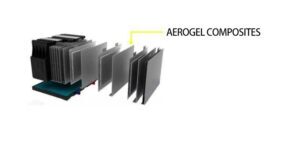Application of aerogel in power battery
xinstDec 29, 2020
The high temperature tolerance of aerogel solves the pain points of ternary battery safety. When the on-board battery outputs electric energy for a long time, the long-term chemical reaction in the battery will cause the battery body to heat up obviously, and there is a risk of burning and explosion. Traditional core modules use plastic separators to separate the batteries from each other, which is of no practical use.
This is not only heavy but also unable to protect it, and it is easy to cause problems such as excessive battery temperature, which may cause the separator to dissolve and catch fire. The existing protective felt has a simple structure and is easy to deform, so that it cannot fully contact the battery pack, and it cannot provide a good heat insulation effect when the battery heats up severely. The aerogel composite material There is hope to solve this pain point.
Ternary batteries have higher requirements for safety. Its advantages lie in two aspects: energy storage density and low temperature resistance:
1) Energy storage density, the energy density of ternary lithium batteries is 170-200Wh/kg, and the energy density will be further increased in the later period, while the energy density of lithium iron phosphate batteries is 140- 160Wh/kg;
2) Low temperature performance, the lower limit of low temperature use of ternary lithium battery is -30℃, and the lower limit of low temperature of lithium iron phosphate battery is -20℃. Under the same low temperature conditions, the ternary lithium battery will not attenuate in winter To 15%, the attenuation of lithium iron phosphate batteries is as high as 30%.
However, due to the higher energy density of the ternary battery, the stability and safety of the battery are relatively poor, and it is more dependent on high-performance flame-retardant materials to enhance the safety performance of the ternary battery system.

Power batteries are developing rapidly, with ternary batteries occupying a major share. According to data, from January to July 2020, the total installed capacity of power batteries in my country is 22.5GWh. Among them, the cumulative installed volume of ternary batteries is 15.9GWh, accounting for 70.6% of the total installed volume; the cumulative installed volume of lithium iron phosphate batteries is 6.5GWh, accounting for 28.8% of the total installed volume. It is estimated that the global shipment of ternary anodes will reach 1.5 million tons in 2025.
As a flame-retardant material, aerogel composite material has the advantages of light weight, excellent flame-retardant performance, and environmental protection performance compared with traditional flame-retardant materials. At present, there are two main types of heat-insulating and flame-retardant materials used in new energy vehicle battery core modules:
1) Plastics such as PP, ABS, PVC, etc., among which ABS engineering plastics are the main ones. Flame retardants are usually added to PP, ABS and other plastics to make flame-retardant plastics;
2) Fireproof felt made of glass fiber, ceramic fiber cotton and other fireproof materials. As an emerging material, aerogel has excellent thermal insulation and flame retardant properties. Aerogel composite materials composed of aerogel and engineering materials have extremely excellent flame retardant properties. The SiO2 aerogel fiberglass felt composite material developed by Panya Microtransmission. The thermal conductivity of this type of material can reach below 0.017W/(m〃k) at a normal temperature of 25°C, and the thermal conductivity is medium at a high temperature of 600°C. Between 0.047~0.066W/(m〃k), it can increase the high temperature endurance of the battery pack to over 800℃.


